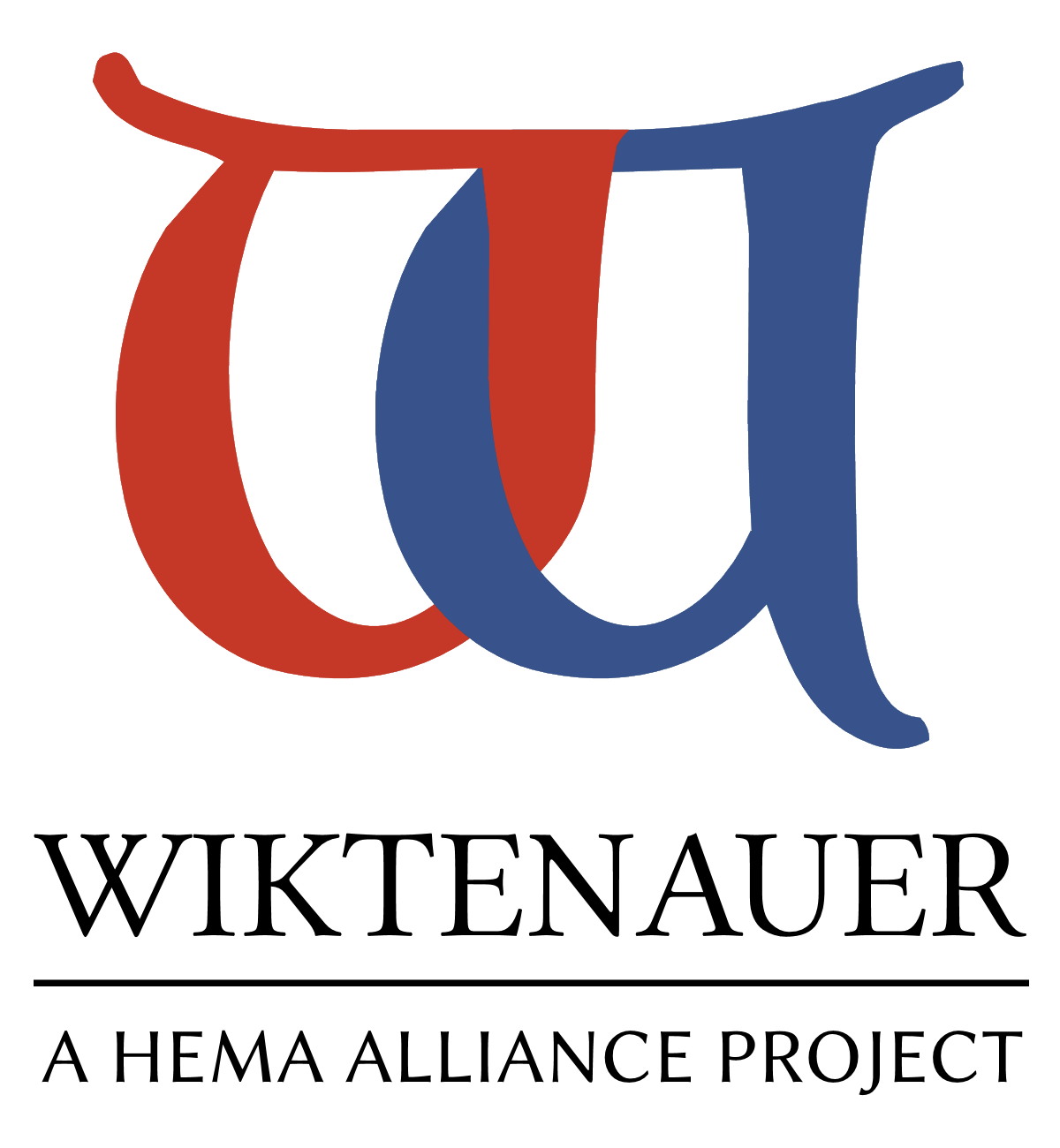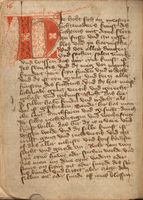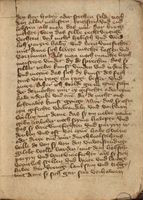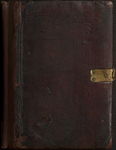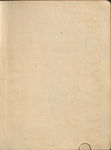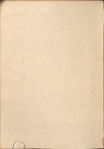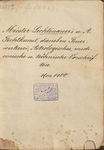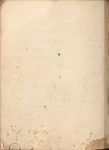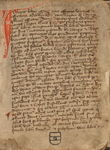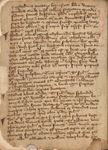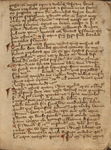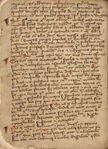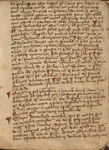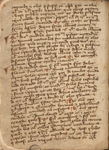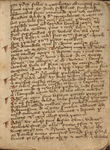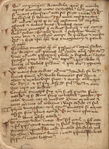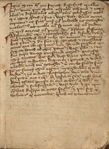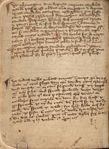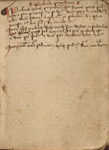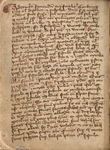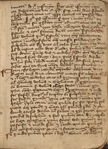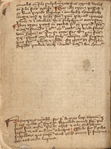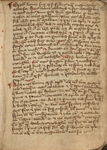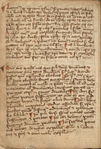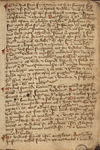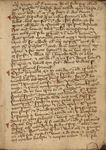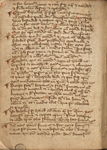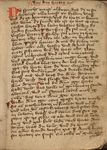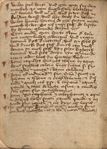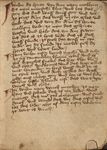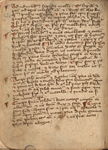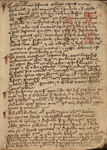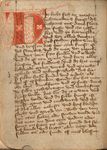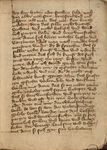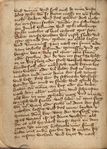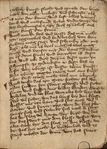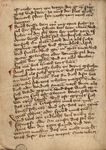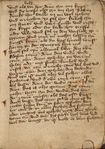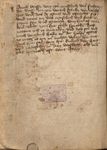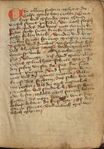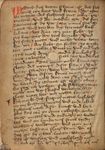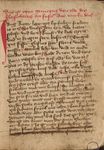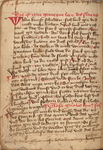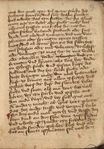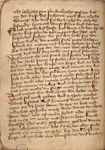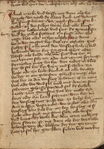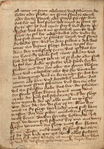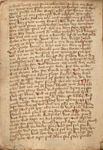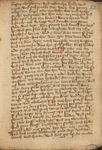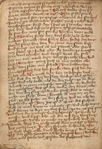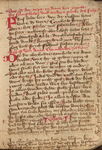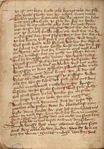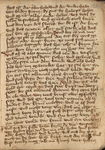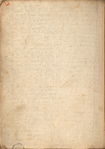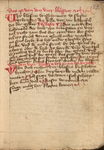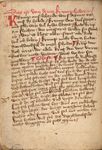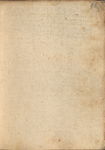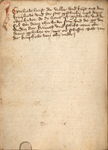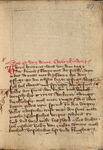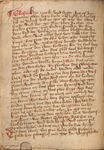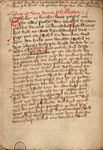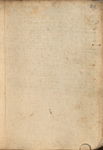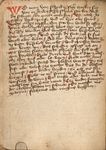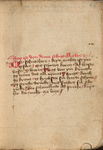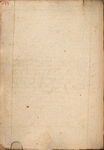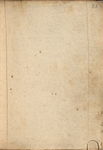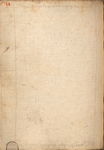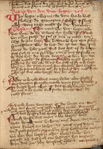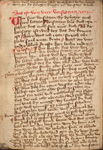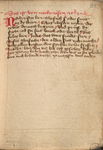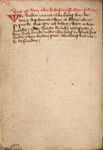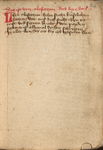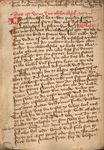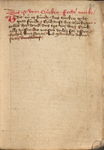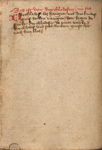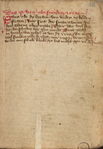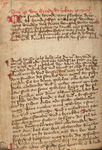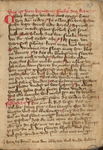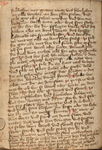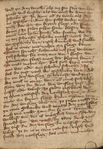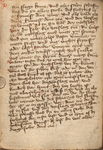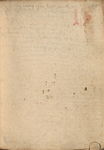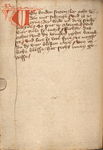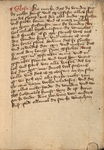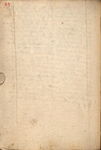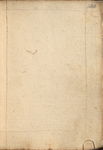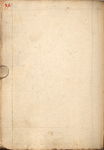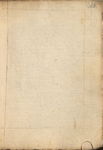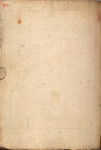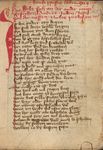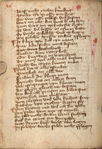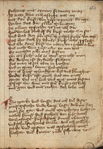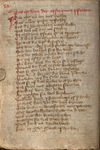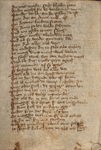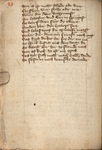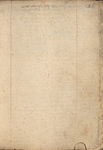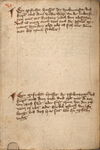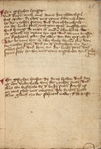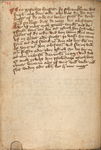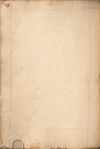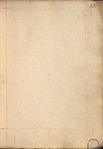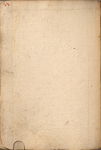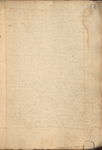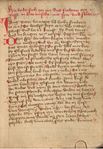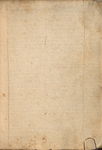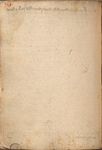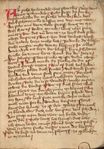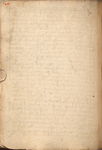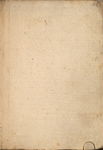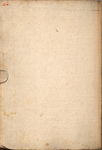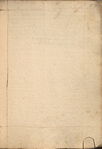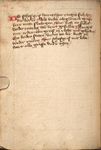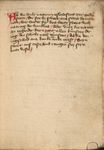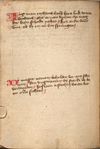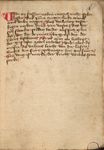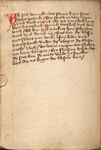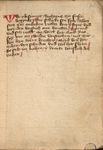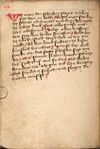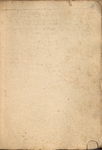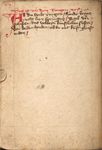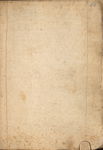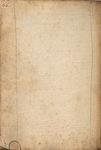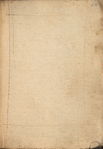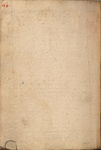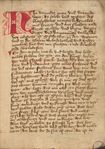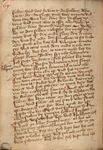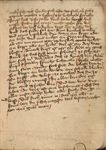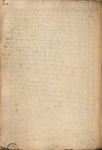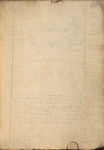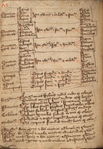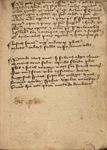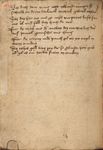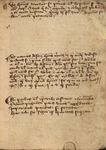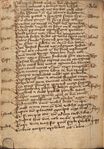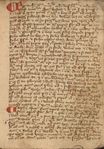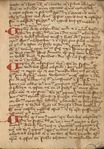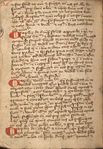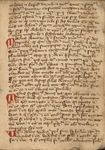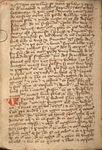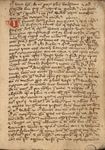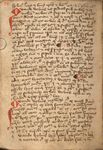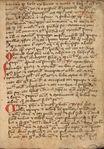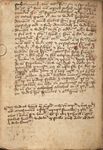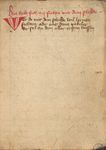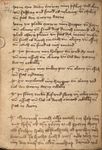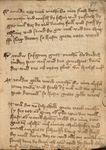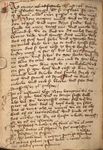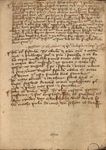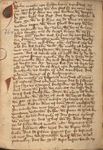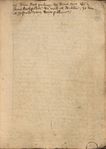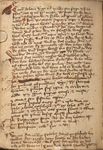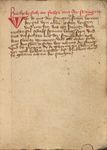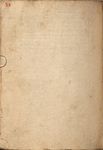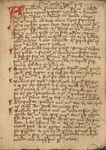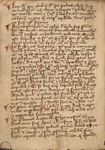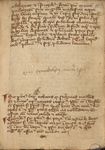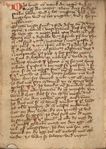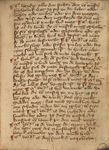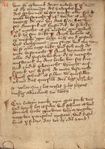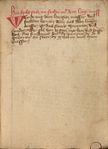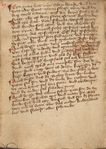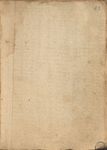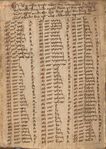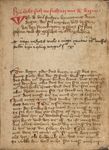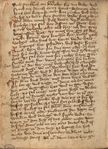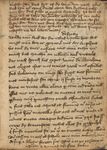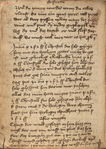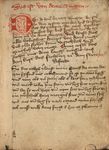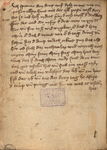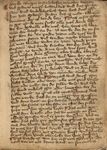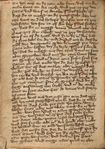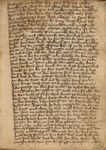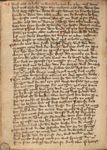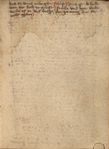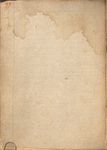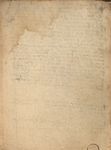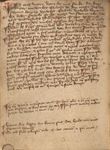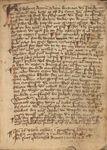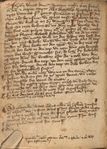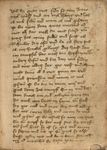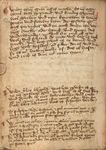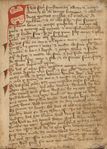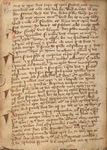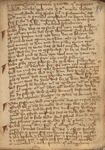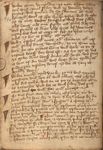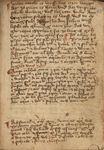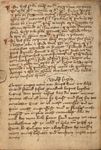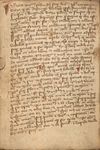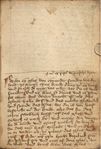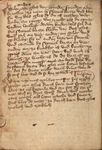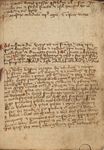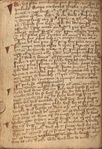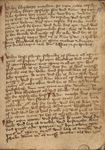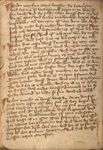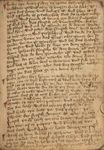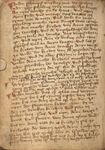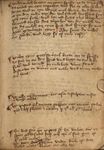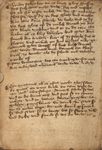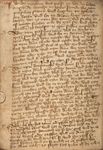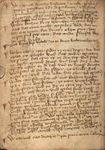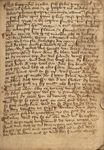| 1r - 5v
|
Liber Ignium by Marcus Graecus
|
| 5v
|
[edit] Complete Translation 
by Ondrej Vodicka
|
Transcription [edit]
by Ondrej Vodicka
|
In order to see a thousand armed knights in front of you in the field etc., cut off a branch of a willow tree with a single cut and wash it before sunrise in running water for seven days and say: "Gribello, come, you are coming with a thousandfold magnificence, I ask you by Astaroth, that you come with help of thousand-strong force." After you have said this ten times, take the rod and hit the ground three times and say the credo ten times, lift the rod in your hand, and now you can see 100 knights etc. in full armour etc.
|
[5v] ¶ Ut videas mille milites armatis in campo ante te etc. Haw mit eynem slage von eyner weiden eynen czweyk und wasche yn in eynem flissendem wasser VII tage ante ortum solis, und sprich: Gribello, venite, venitis cum mille granditate, quaesso vos per Astaroth, quatenus veniatis cum milleno forte auxilio. Und wen du daz hast X gesprochen so nym dy ruten und slach sy III an dy erde und sprich X credo, czu hant hebe auf dy ruten, zo systu C ritter etc. mit vollem harnüsch etc.
|
If you want them to disappear, throw the rod away on the ground, and the rod has no power anymore etc.
|
¶ Si vis, ut recedant, proice vel iacta virgulam super terram, et tunc nulli plus valebit illa virga etc.
|
|
| 6r
|
Recipes for powders used for painting
|
| 6v - 10v
|
Latin recipes (paint, alchemy, medicine)
|
| 11r - 12r
|
Von dem herten by "Master Alchemy"
|
| 12v - 13r
|
Alchemical recipes in Latin
|
| 13v - 17v
|
Fencing advice by Pseudo-Hans Döbringer
|
| 18r - 40r
|
Gloss of Liechtenauer's long sword by Pseudo-Hans Döbringer
|
| 43r - 52v
|
Long sword by Andres Juden, Jobs von der Nyssen, Nicklass Prewßen, and "the Priest" Hans Döbringer
|
| 53r - 59v
|
Poem on mounted fencing, combining verses from Johannes Liechtenauer, Martin Huntsfeld, and others
|
| 60r - 61r
|
Recital on short sword by Johannes Liechtenauer
|
| 64r - 65r
|
Conclusion of the teachings of Liechtenauer by Pseudo-Hans Döbringer
|
| 66v - 67r
|
Astrological texts, magical and medicinal recipes, name magic
|
| 67v
|
[edit] Draft Translation 
by Ondrej Vodicka
|
Transcription [edit]
by Ondrej Vodicka
|
So that your enemy can not prevail over you, write on three separate leafs Michael, Gabriel, Raphael.
|
[67v] Daz dich dein veint icht uberbind muczen, so schreib an drew larlawb Michael, Gabriel, Raphael.
|
So that your hair does not fall out, mix some burned flax seed with oil and spread the skin with it.
|
Daz daz har nit auß ge, misch verprent linsat sam mit öl und salb daz haup da mit.
|
And for the sin under the face of the night, put flour mixed with honey on it.
|
Et für dy mail unter dem antlucz dez nachtes, leg dar auf pomnel gemischet mit hönig.
|
And for worms in stomach, put 15 nails in his wine.
|
Et für dy würm in dem pauch gib im XV nagel in wein trinken.
|
Carry the gall of a roe deer with you in order to win the favor of the lord, or put it into the drink of a beautiful lady.
|
Dez rehes gall trag pey dir so gebinstu herren gnad, oder gib es einer czarten fraün in trinken.
|
|
| 68r - 73v
|
Astrological texts, magical and medicinal recipes, name magic
|
| 74r
|
Sword and buckler teachings by Pseudo-Hans Döbringer
|
| 74v - 77v
|
Recipes for paint, tumors, metal and ivory treatment
|
| 78r
|
Staff teachings by Pseudo-Hans Döbringer
|
| 79r - 81v
|
Miscellaneous Latin recipes, treatment of gems, preparation of a miraculous potion
|
| 82rv
|
Messer teachings by Pseudo-Hans Döbringer
|
| 83v
|
Interval between Epiphany and Ash Wednesday for years 1390-1495
|
| 84r - 85r
|
Dagger teachings by Pseudo-Hans Döbringer
|
| 85rv, 86rv
|
Magical recipes
|
| 86r, 87r - 89r
|
Grappling teachings by Pseudo-Hans Döbringer
|
| 90v - 91v
|
Medical Recipes for the Mouth and Teeth
|
| 92r
|
[edit] No Translation 
|
Transcription [edit]
by Helmut Werner Klug, et al.
|
|
|
[92r] Wil du guten met siden so nim drew
tayl wasser vnd ain tayl hoenig vnd las
es wol siden vnd wann es wol gesoten
ist So nÿm dann czway viertail oder
mer all dar nach du met seüst vnd
trag das in ein stüben vnd seczt es
?[6] hinder den ofen vnd la es sten pis
es ein hewbel gebingt daz haist dan
ein tampfel dar nach tue hopfen in den
andern hefen vnd laz dan wol siden
vnd rür albeg dar gar vast vnd chum
nicht dauon oder der met prün an vnd
wuerd prv̈nssen vnd[7] wann er wol
gesoten ist So tue in inein vas vnd
geüs dann das tampfl hin in vnd lazz
dann durch ein ander arbayten
|
|
|
Item czu
der varb nim lauttern saym vnd seud
den gar wol vnd ruer den auch albeg
dar mit einem holcz vnd wenn dy varb
wol gesoten ist So versuch sy nim ein pret
lein vnd trapf sy dar auf stent dy tropfen
vnd sind hert so ist sy güt vnd wenn
sy schonn vnd rot ist So geus sy also
haisse in den met vnd la in dann sten acht
tag oder vierczehen So hastu gueten met
|
|
| 92r - 161v
|
Various alchemical recipes, food recipes, nonsense recipes, in various hands
|
| 109r, 113v, 119v - 120r
|
[edit] No Translation 
|
Transcription [edit]
by Helmut Werner Klug, et al.
|
|
|
[109r.1] ¶ Wiltu eÿn huen siden in eÿme kodrolf der
vnden weit ist vnd oben eyn engen hals hat zo
nym das huen vnd woerge is vnd bloze is of
vnd pflocke is sewberlich das dÿ hawt nicht
reisse vnd sneide is vorne an deme bawche
of vnd loeze das fleisch ab vmmevndvem bis an
dÿ floegel vnd an dÿ gelenke in den beÿnen vnder
den dÿen vnd sewt das fleisch wol vnd hacke
is mit eyern vnd petersilgen vnd tu den dy hawt
von deme huene yn das glas alzo gancz wen sÿ
weder vor czu ist genehet vnd loz das hawpt
hÿ aüsen vnd velle sy denne yn dem glaze mit
deme gehacken fleische von dem hune ader mit dem
voelsal das do von gemacht ist vnd gews denne
wasser dor ÿn ader iewche czu deme hune
vnd las is denne wol irwarmen vnd siden yn eÿme
toppe mit wasser alzo das daz wasser nicht
oben ÿn das glas ge czu deme hune
|
|
|
[109r.2] ¶ Wiltu geverbete huener machen wÿ du wilt zo
nÿm eyn eÿ vnd bestreich is wol mit leÿn oel
vnd loz is wol trucken an der zonnen vnd streich
denne waze varbe du wilt an das eÿ vnd loz
is aber trucken vnd leg das eÿ vnder eÿne
henne das sÿ is aus bruete m ander eyern
zo wirt das hun denne gestalt noch der varben
|
|
|
[109r.3] ¶ Mache eyn tyer von papyer vnd mele das
wy du wilt vnd tu eynen frosch oder grille dor yn
vnd halt eÿn licht vor das papyer zo
schreit der frosch dorÿne v ader tu eÿn
frosch ÿn eyn loch an eyner want vnd mole
eÿn tier of eyn papyer vnd kleybe is vor
das loch vnd halt eyn licht doran ut supra
|
|
|
[109r.4] ¶ Stich eyn hun durch syn gehirne vnd czu reib
eÿn crawt daz heist hürses[8] czunge vnd schoecz
im ÿn dÿ wunde zo wirt is weder gesunt
[9]
|
|
|
[110r.1] ¶ Wiltu milch broten an eÿme spisse zo tu czum erste
dÿ milch yn eyn toppelyn vnd sla eyn ader czweÿ
dorÿn vnd tu eÿn wennig mel dorczu vnd henge
is ÿn den andern top der vol sidende wassers seÿ
peÿ eynem fewer vnd laz ich sichs alzo coaguluem
dornoch czu sla das toeppelÿn von der milch vnd
stoz dÿ milch an eÿnen spis vnd sprenge sy mit
guten gewoertzten eÿern ¶ Ader sneit dÿ milch
czu stoecken vnd lege sy of eynen rost /
|
|
|
[110r.2] ¶ Wiltu eÿnen petterstroeczel broten an eym spisse
zo stoz in an den spis vnd lege in czu dem
fewer vnd wende in endelich vmme vnd
bestrewe in vmm[10] mit mele vnd tu in nicht
czu heis /
|
|
|
Paragraphs 3-6 on 110r are not about cooking
|
|
|
[110v.1] ¶ wiltu secherley ÿn eyn lang glas giessen
das sich eÿns nicht vnder daz ander mische
So nym czum ersten milch wen daz ist ain aller
swersten vnd dÿ ÿn das glas vnd mache
denne eÿne dunne scheibe von holcz vnd tu dÿ
ÿn das glas of dÿ milch dornoch nym denne
eyn kleyn trichter vnd tu ÿn dÿ roere eÿn
halm ader eyn kleyn hoelczlÿn vnd gewz denne
durch den trichter bier of dÿ scheibe das is
kleÿne vnd melich an dem hoelczel nider ge
dornoch gewz wasser of das bier? dornoch
roten weyn dornoch mete dornoch czu oeberst
leynoel zo weicht als dÿ scheibe mit itzlichem
tranke of
|
|
|
[110v.2] ¶ Item winterczeit las eÿn trank gevrisen noch
dem andern vnd meynnander wider tawen & idem valet
|
|
|
[110v.3] ¶ Eÿn quittemus ader eyn confect mache alzo sewt
dÿ quitten ÿn irem brodem ÿn eynem toppe do
eÿn ander öberstoeuze donach schele sÿ wol
vnd tu dy kerne aus vnd stos sÿ in eynem
moerser vnd tu woercze darczu ÿngeber negeleÿn
pariskoerner vnd honik vnd sewt sÿ
yn eym newen toppe der mit honik gesmert
sÿ vnd sewt sy zo lange bis sÿ swarcz werden
vnd dicke vnd sneide sÿ wÿ du wilt &c
|
|
|
[113v.1] ¶ Wiltu machen das petersilge vor den lewten
czusehende wachse in eÿner stunde So nÿm
petersilien somen vnd lege in yn gebranten
weÿn vnd loz in dorynne legen eyne gute
weÿle dor zo nÿm den zomen vnd strewe in
of truege fuechte erde dy geÿl sey vnd cleÿne
gereden zo wechset zi gar schire czu sehende
|
|
|
[113v.2] Aliud/ · Ader / nym petersilien zamen vnd tu den er in
guten starken essik vnd loz in dorynne legen
eynen tag vnd rÿne nacht wen das nue geschiet
zo nym denne chaw vnd asche vnd menge
das vndereynnander das is nicht czu dicke noch
czu duenne werde vnd nym denne den zomen vnd
strewe ader zehe in of das gemenge von den
chalwe vnd der aschen vnd nym denne andere
warme asche vnd strewe sÿ dorof / & videbis
|
|
|
[113v.3] Aliud/ · Ader nÿm bonstengel vnd bruee sÿ czu aschen
vnd nym denne petrisilgen zomen vnd lege in ÿn
guten starken weÿn vnd loz in dorynne legen vier
tag vnd vier nacht ader lenger is der weyn nicht
stark genuk vnd nÿm denne den be zomen aus
dem weÿne vnd loz in trucken werden vnd nÿm
denne trucken erde dÿ gar cleÿn sÿ vnd gereden
durch eÿn tuch Vnd nÿm denne dez selben ertrichz
czweÿteÿl vnd der vorgenanten aschen
eÿn teÿl vnd tu is mit eynander alzo gemengt
in eÿne schuessel vnd strew denne den petersilien
zomen dorof vnd besprenge is denne mit lawterm
regen wasser / vnd decke denne eyn mantel
doroeber eyn cleÿne weÿle vnd heb in denne off
zo siestu schoene petercilien gewachzen voer dir &c.
|
|
|
[113v.4] Aliud/ ¶ Aber nym kerbes zomen ader pfeben zo vnd lege in
yn menschen blut vnd loz in dorynne legen an der
zonnen vij tage dornoch nym sy her aus vnd tu is
ÿn eyn butel ader taschen vnd nym denne geile
veiste erden vnd trucken sÿ vnd czu reis sy
gar kleyne vnd tu sÿ auch in eyn tuechel wen
du denne wilt zo schot das puluer of dÿ erden
|
|
|
Paragraph 1 on 119v is not about cooking
|
|
|
[119v.2] ¶ Wiltu kochen drey gerichte in eyme toppe
das daz eÿne nicht gesalczen werde daz ander
czu moze daz dritte alczu sere daz
erste sal seyn eyer das ander fleisch daz
dritte krebs
|
|
|
[119v.3] ¶ das keÿne kese vawlen zo tu dorÿn krawzenmincze etc.
|
|
|
[119v.4] ¶ Wiltu czweÿ eÿer siden in eynem toppe daz das
eÿne ro bleybe vnd das ander gezoten
zo s lege daz eÿne eÿ in den top vnd schoete
asche genuk dorof vnd lege das ander
of dÿ asche in den top vnd tu wasser doreÿn
vnd setze is czu dez fewer zo bleibt das
erste ro vnd daz ander daz aber wert gezoten
|
|
|
[119v.5] ¶ Wiltu eÿer siden bey ader mit kaldem wasser
vil e denne bey fewer zo nÿm vngeleschte
kalt steyne vnd tu dy in eynen top vnd lege
dy eyer och dorczu vnd gewz kalt wasser in
den top zo werden si siden / vnd eyer in vngeleschten
kalk gelegt dy werden in kurczer stunt gel
|
|
|
Paragraphs 6-10 on 119v and 1 on 120r are not about cooking
|
|
|
[120r.2] ¶ Wiltu eÿn eÿ als gros machen als eyn hawp
ader bozekawle So nym czwenczik ader dreissik
eyer vnd czu sla das ^weiz von den eyern sunderlich
vnd dy toeter auch sunderlich vnd nym denne eÿne
bloze vnd gews das weisse vor doreyn dornoch
dÿ toeter +# {dornoch aber oben eyn wennig weisses doch daz
dy blose nicht gar vol seÿ zi czureist anders Auch
magstu dy toter vor eyn wennig czu druecken
vnd henge sy eynen tag ÿn eÿne ander bloze daz
sÿ sich coaguliren vnd tu sy denne In dy bloze
czu dem weissen ut supra} vnd bÿnt denne dÿ bloze wol czu vnd
tu dÿ in eynen top der vol sidende wasser sey bey
eynem fewer vnd das daz wasser oeber dÿ bloze ge
vnd decke den top wol czu das keyn brodem heraus
ge vnd los is alzo siden dornoch nym dÿ
bloze heraus vnd tu sÿ ap vnd sneit denne daz
ey of zo ist mitten der l toter komen vnd vmmevndvem
das weisse wen der toter flewt dy hitcze
[11] vnd helt sich in dÿ mitte als hastu eyn gut eÿ
|
|
|
[120r.3] ¶ Wiltu denne dem
eÿ eyne schale machen zo czu stos dÿ eÿerschalen
vnd temperir sÿ m oele vnd mit kreyden
vnd bestreich auswennik dÿ bloze mete &c.
Auch wen das ey czu dem ersten eyn wennig behaisset
zo stich mit eyme griffel ader nodel doreyn
daz der brodem aus ge vnd daz si nicht zerreisse
|
|
| 161v - 165v
|
"Horse pharmacopeia" (Rossarzneibuch) by Master Albrant
|
| 166r - 169v
|
Index to the recipes in the manuscript, partly illegible
|
